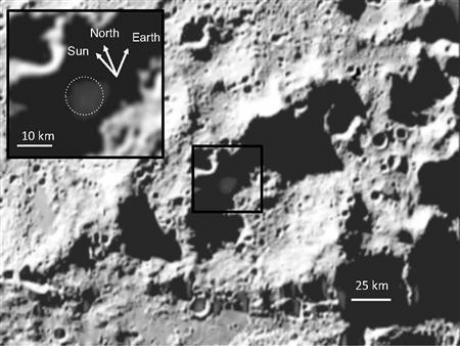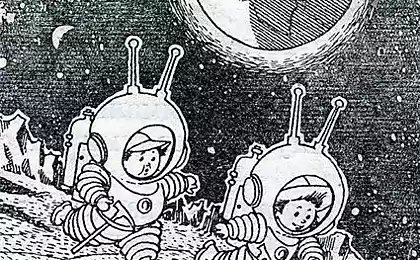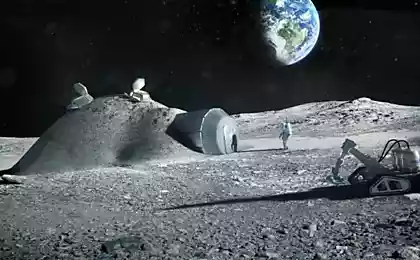485
On the moon, found water.
On the Moon, the crater Cabeus (Cabeus), discovered large amounts of water in the form of ice, carbon monoxide, ammonia and the silvery metals, reports Reuters. All of these findings have been made after the crater, located in the shadow fell carrier rocket put into orbit lunar satellite NASA. After the fall of the crater a cloud of dust, the contents of which were analyzed with the help of satellite LCROSS. Articles about the new findings published in the journal Science.

"This place is like a treasure chest - elements that are on the surface of the moon, but until recently was in the shadows," - said Peter Schultz (Peter Schultz), a planetary geologist at Brown University (Brown University), Massachusetts, USA. Data on the composition of the clouds were obtained by analyzing the color spectrum of the cloud. The weight of the dust cloud is estimated at 4-6 thousand. Kg, and its width was 25 to 30 m. It was found that 5 to 6% cloud that rose above the surface of the moon after the fall of the rocket, was ice.
The presence of water on the lunar surface could indicate life on Earth satellite. But the presence of silver represents a danger to humans. It is toxic and may hinder the development of the satellite in the future.
Recall that the fact that the lunar surface was water, casts doubt on the basic theory of the origin of the Earth's natural satellite. It is believed that the Moon was formed as a result of a collision with another object of the Earth on a planetary scale. At this point, the future moon warmed up so that all the water has evaporated from the surface. This indirect evidence and analysis of lunar soil brought back to Earth on the American spacecraft "Apollo-16».
The study was based on a comparison of the contents in the lunar soil of different isotopes of chlorine. Chloro-35 has two neutron less than chlorine-37, and so it is more susceptible to evaporation from ocean magma. But if magma containing large amounts of hydrogen, for example, composed of water, it is required to be joined react with chlorine. As chloro-37-chloro or 35 is connected to the water and evaporates. So if initially on the lunar surface containing hydrogen, the ratio of chlorine-chlorine-35 and 37 would be approximately the same everywhere; However, the analysis of eleven samples showed that this ratio varies greatly. Thus, it was concluded that the original on the surface of the moon was no water.
There are studies that confirm the presence of water on the moon. So, in 2008 in the study of volcanic glass scientists have suggested that it was formed in the aquatic environment. Then, from the analysis of the lunar apatite, it was concluded that the Moon originally contained a considerable amount of water - about the same as in the interior of the Earth.
There is only one explanation for these conflicting results: in different parts of the Moon contained and contain different amounts of water.
Source:

"This place is like a treasure chest - elements that are on the surface of the moon, but until recently was in the shadows," - said Peter Schultz (Peter Schultz), a planetary geologist at Brown University (Brown University), Massachusetts, USA. Data on the composition of the clouds were obtained by analyzing the color spectrum of the cloud. The weight of the dust cloud is estimated at 4-6 thousand. Kg, and its width was 25 to 30 m. It was found that 5 to 6% cloud that rose above the surface of the moon after the fall of the rocket, was ice.
The presence of water on the lunar surface could indicate life on Earth satellite. But the presence of silver represents a danger to humans. It is toxic and may hinder the development of the satellite in the future.
Recall that the fact that the lunar surface was water, casts doubt on the basic theory of the origin of the Earth's natural satellite. It is believed that the Moon was formed as a result of a collision with another object of the Earth on a planetary scale. At this point, the future moon warmed up so that all the water has evaporated from the surface. This indirect evidence and analysis of lunar soil brought back to Earth on the American spacecraft "Apollo-16».
The study was based on a comparison of the contents in the lunar soil of different isotopes of chlorine. Chloro-35 has two neutron less than chlorine-37, and so it is more susceptible to evaporation from ocean magma. But if magma containing large amounts of hydrogen, for example, composed of water, it is required to be joined react with chlorine. As chloro-37-chloro or 35 is connected to the water and evaporates. So if initially on the lunar surface containing hydrogen, the ratio of chlorine-chlorine-35 and 37 would be approximately the same everywhere; However, the analysis of eleven samples showed that this ratio varies greatly. Thus, it was concluded that the original on the surface of the moon was no water.
There are studies that confirm the presence of water on the moon. So, in 2008 in the study of volcanic glass scientists have suggested that it was formed in the aquatic environment. Then, from the analysis of the lunar apatite, it was concluded that the Moon originally contained a considerable amount of water - about the same as in the interior of the Earth.
There is only one explanation for these conflicting results: in different parts of the Moon contained and contain different amounts of water.
Source:
























